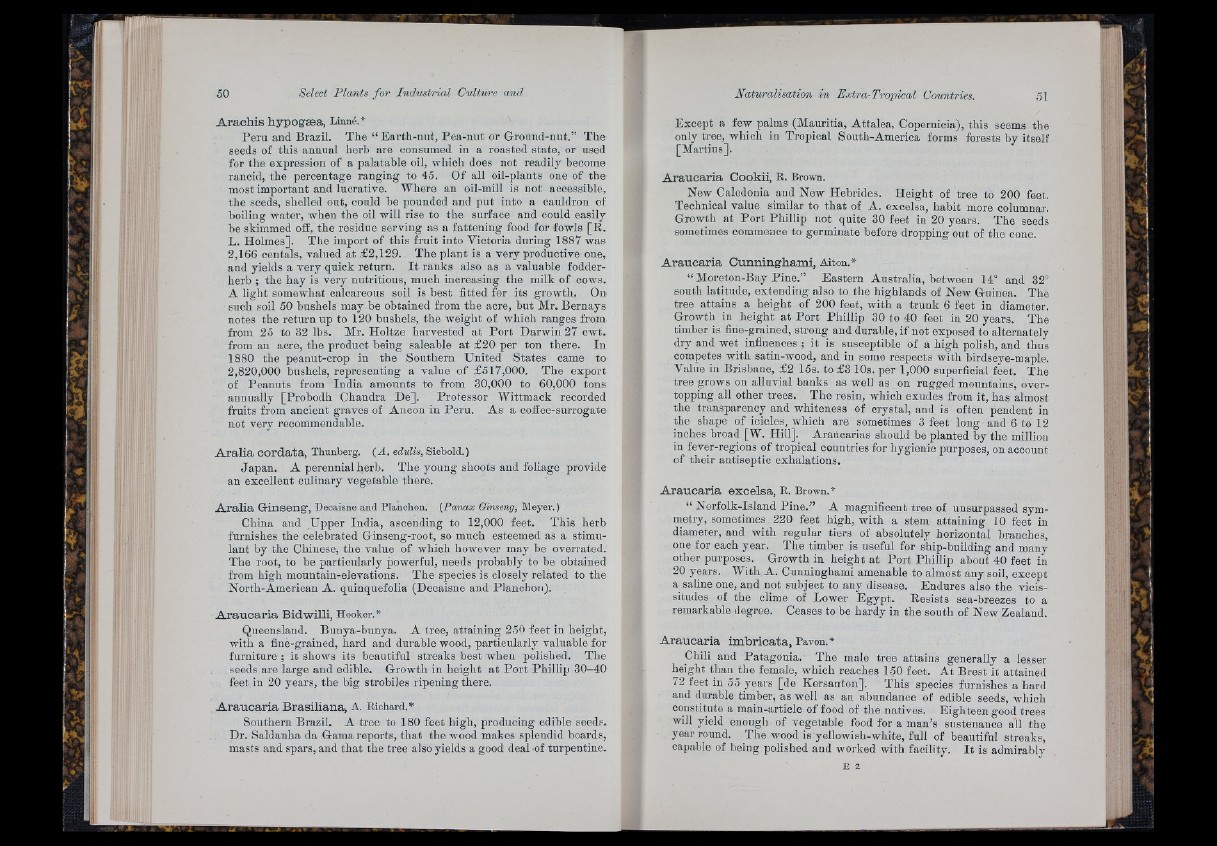
A ra c h is h y p o gæ a , Linné.*
Peru and Brazil. The “ Earth-nut, Pea-nut or Gronnd-nut.” The
seeds of this annual herb are consumed in a roasted state, or used
for the expression of a palatable oil, which does not readily become
rancid, the percentage ranging to 45. Of all oil-plants one of the
most important and lucrative. Where an oil-mill is not accessible,
the seeds, shelled out, could be pounded and put into a cauldron of
boiling water, when the oil will rise to the surface and could easily
be skimmed off, the residue serving as a fattening food for fowls [P .
L. Holmes]. The import of this fruit into Victoria during 1887 was
2,166 centals, valued at £2,129. The plant is a very productive one,
and yields a very quick return. I t ranks also as a valuable fodder-
herb ; the hay is very nutritious, much increasing the milk of cows.
A light somewhat calcareous soil is best fitted for its growth. On
such soil 50 bushels may be obtained from the acre, but Mr. Bernays
notes the return up to 120 bushels, the weight of which ranges from
from 25 to 32 lbs. Mr. Holtze harvested a t Port Darwin 27 cwt.
from an acre, the product being saleable a t £ 20 per ton there. In
1880 the peanut-crop in the Southern United States came to
2,820,000 bushels, representing a value of £517,000. The export
of Peanuts from India amounts to from 30,000 to 60,000 tons
annually [Probodh Chandra De]. Professor Wittmack recorded
fruits from ancient graves of Ancon in Peru. As a colfee-surrogate
not very reeommendable.
A r a lia c o rd a ta , Thunberg. (A. eduUs, Siebold.)
Japan. A perennial herb. The young shoots and foliage provide
an excellent culinary vegetable there.
A r a lia G in sen g , Decaisne and Planchón. (Panax Ginseng, Meyer. )
China and Upper India, ascending to 12,000 feet. This herb
furnishes the celebrated Ginseng-root, so much esteemed as a stimulant
by the Chinese, the value of which however may be overrated.
The root, to be particularly jiowerful, needs probably to be obtained
from high mouUtain-elevations. The species is closely related to the
North-American A. quinquefolia (Decaisne and Planchón).
A r a u c a r ia Bidwilli, Hooker.*
Queensland. Bunya-bunya. A free, attaining 250 feet in height,
with a fine-grained, hard and durable wood, particularly valuable for
furniture ; it shows its beautiful streaks best when polished. The
seeds are large and edible. Growth in height a t Po rt Phillip 30-40
feet in 20 years, the big strobiles ripening there.
A r a u c a r ia B ra s ilia n a , A. Richard.*
Southern Brazil. A tree to 180 feet high, producing edible seeds.
Dr. Saldanha da Gama reports, th a t the wood makes splendid boards,
masts and spars, and that the tree also yields a good deal of turpentine.
Except a few palms (Mauritia, Attalea, Copernicia), this seems the
only tree, which in Tropical South-America forms forests by itself
[Martins].
A ra u c a r ia Cookii, R. Brown.
New Caledonia and New Hebrides. Height of tree to 200 feet.
Technical value similar to th a t of A. excelsa, habit more columnar.
Growth at Po rt Phillip not quite 30 feet in 20 years. The seeds
sometimes commence to germinate before dropping out of the cone.
A r a u c a r ia C u u u iu g h am i, Alton.*
“ Moreton-Bay Pine.” Eastern Australia, between 14° and 32°
south latitude, extending also to the highlands of New Guinea. The
tree attains a height of 200 feet, with a trunk 6 feet in diameter.
Growth in height a t Po rt Phillip 30 to 40 feet in 20 years. The
timber is fine-grained, strong and durable, if not exposed to alternately
dry and wet influences ; it is susceptible of a high polish, and thus
competes with satin-wood, and in some respects with birdseye-maple.
Value in Brisbane, £2 15s. to £3 lOs. per 1,000 superficial feet. The
tree grows on alluvial banks as well as on rugged mountains, overtopping
all other trees. The resin, which exudes from it, has almost
the transparency and whiteness of crystal, and is often pendent in
the shape of icicles, which are sometimes 3 feet long and 6 to 12
inches broad [W. Hill], Araucarias should be planted by the million
in fever-regions of tropical countries for hygienic purposes, on account
of their antiseptic exhalations.
A r a u c a r ia ex c e lsa , R. Brown.*
“ Norfolk-Island Pine.” A magnificent tree of unsurpassed symmetry,
sometimes 220 feet high, with a stem attaining 10 feet in
diameter, and with regular tiers of absolutely horizontal branches,
one for each year. The timber is useful for ship-building and many
other purposes. Growth in height a t P o rt Phillip about 40 feet in
20 years. With A. Cunninghami amenable to almost any soil, except
a saline one, and not subject to any disease. Endures also the vicissitudes
of the clime of Lower E g y p t. Resists sea-breezes to a
remarkable degree. Ceases to be hardy in the south of New Zealand.
A ra u c a r ia iru b ric a ta , Pavon.*
Chili aud Patagonia. The male tree attains generally a lesser
height than the female, which reaches 150 feet. At Brest it attained
i2 feet in 55 years [de Kersanton], This species furnishes a hard
and durable timber, as well as an abundance of edible seeds, which
constitute a main-article of food of the natives. Eighteen good trees
will yield enough of vegetable food for a man’s sustenance all the
year round. The wood is yellowish-white, full of beautiful streaks,
capable of being polished and worked with facility. I t is admirably